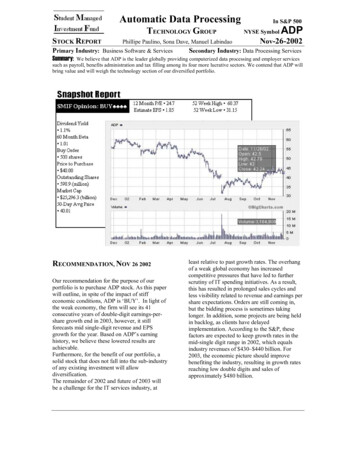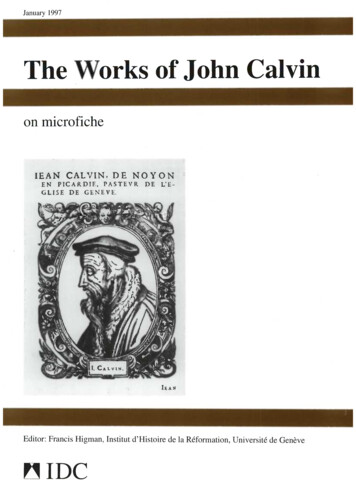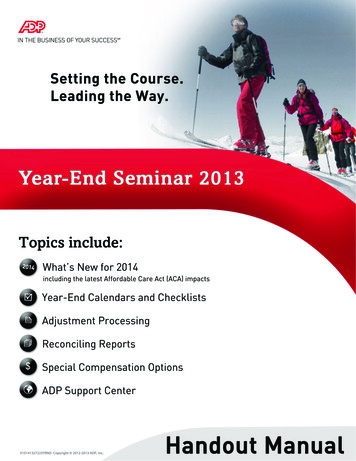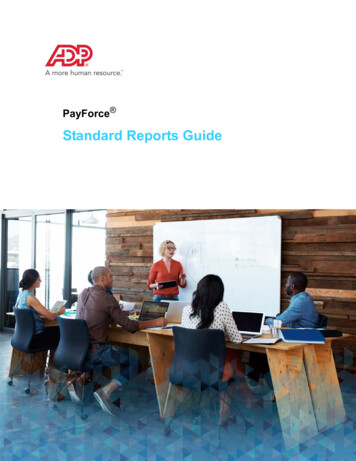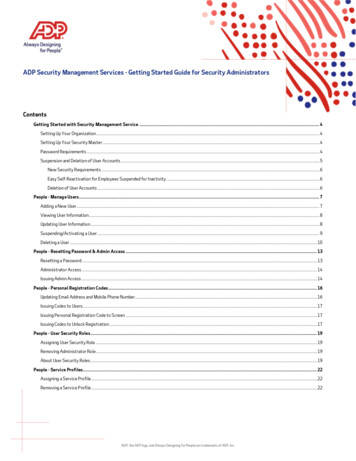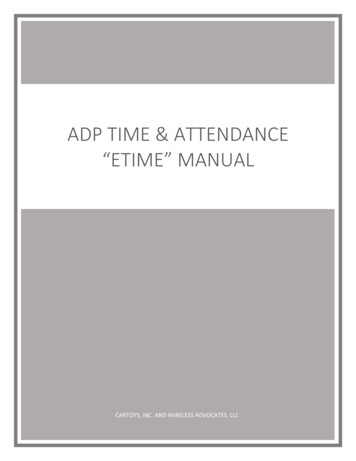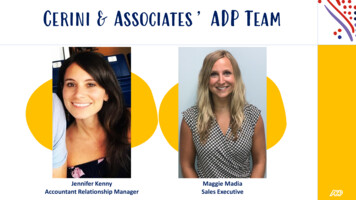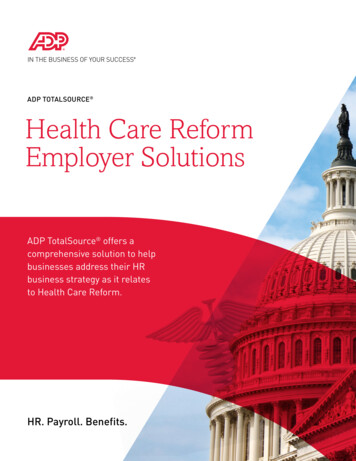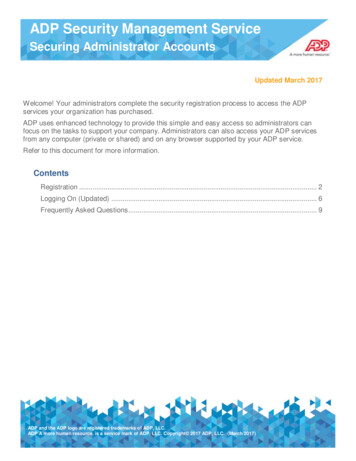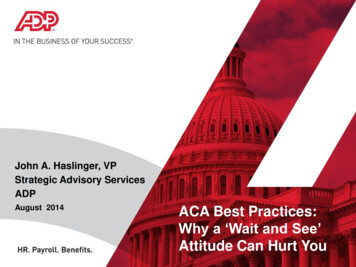
Transcription
John A. Haslinger, VPStrategic Advisory ServicesADPAugust 2014ACA Best Practices:Why a ‘Wait and See’Attitude Can Hurt You
Today’s SpeakerJohn A. HaslingerADP 2Join the conversation on Twitter by tweeting along orfollowing #ACA Copyright 2014 ADP, LLC. Proprietary Information.
Best Practices Are Based On Three Criteria Keep employer costs as low as possible Minimize administrative effort Ensure compliance with ACA requirementsADP DOES NOT PRACTICE LAW OR GIVE LEGAL ADVICEADP STRONGLY RECOMMENDS THAT CLIENTS OBTAIN QUALIFIED LEGALCOUNSEL PRIOR TO MAKING ANY DECISIONS3 Copyright 2014 ADP, LLC. Proprietary Information.3
Federal Courts Issue Conflicting Rulings (July 22, 2014) Halbig v. Burwell: D.C. Circuit Court of Appeals ruled that federal subsidies were only availablein exchanges established by each individual state The court found that the Affordable Care Act (ACA) plainly states that suchsubsidies, in the form of refundable tax credits, are available only to taxpayers“covered by a qualified health plan . enrolled in through an Exchangeestablished by the State under section 1311 of the [ACA].” Obama administration has asked the full D.C. Circuit court to review the decision King v. Burwell: 4th Circuit Court of Appeals ruled that federal subsidies were legal in bothexchanges established by the states and those established by the federalgovernment Despite agreeing that the plaintiffs’ argument had a “common-sense appeal,”the court ruled that “the applicable statutory language is ambiguous andsubject to multiple interpretations” and deferred to the Obama administration’sinterpretation of the law. Plaintiffs have petitioned the Supreme Court to resolve the conflict between thetwo decisions4 Copyright 2014 ADP, LLC. Proprietary Information.
The ACA Is Not Benefits LegislationIt Is Social Legislation WithFar Reaching Business Impact5 Copyright 2014 ADP, LLC. Proprietary Information.
ACA Will Impact Employers6Individuals Copyright 2014 ADP, LLC. Proprietary Information.Health CareProvidersInsuranceCompaniesPharma &Medical DeviceManufacturers
ACA – Broad Human Capital Management ImpactIT/SystemsFinanceTaxLegal7 Integration Security Data exchange (17 states Washington, D.C., and 8 Federalpartnerships. 26 states no Federalpartnerships / unknown) System updates/change management Data recordkeeping (7 years) Reporting Cost of complying/data modeling Fees/fines/penalty assessments& reconciliation Money movement/remit payments Certify Annual Health Care CoverageReport 1095-BHumanResourcesPayrolland TimeBenefits Receive and reconcile IRS penaltyestimates and appeal whereappropriate Auditing Stay current on complex regulations Interpret law – Federal & StateExchange changes Ensure legal compliance Copyright 2014 ADP, LLC. Proprietary Information.Unknown Communication Employee calls/sharedservice center Reporting Calculating look back period(keep data in sync) Affordability calculation Prepare and distribute newannual report (6055/6056) Compliance communication New plans/wellness/rewards Multi-employer coordination Notice of coverage options Verification of inquiries fromExchanges Receipt of notices fromExchanges Management of reportingdeadlines/ period management Administrative challenges Staff to meet demands
Shared Responsibility (Employer Mandate): DecisionFlow To Avoid Penalties Responsibility – Decision Flow1st Check:Employer has, on average, 100 in2015 (50 in 2016) ACA full-timeemployees plus full-time equivalentemployees in the prior year?Penalties do not apply tosmall employers.NoYes2ndCheck:Does the employer offer minimumessential coverage (MEC) to atleast 70% in 2015 (95% in 2016)of its ACA full-time employees?NoDid at least one employeereceive a premium tax creditor cost-sharing subsidy in aMarketplace/Exchange?YesThe penalty (assessedmonthly) for not offeringcoverage is the number of fulltime employees (minus 80 in2015; 30 in 2016) times 2,000annually.Yes3rd Check:Does the plan provide coverage ofat least 60% minimum value?"NoThose employees can choose tobuy coverage in aMarketplace/Exchange and mayreceive a premium tax credit.Yes4th Check:Would any full-time employees paymore than 9.5% of current year forlowest cost self only coverage Box 1 W-2 Wages, Rate of pay, or Federal Poverty Levelfor self-only coverage?NoThere is no penalty paymentrequired of the employer since itoffers affordable coverage.8YesThe penalty (assessedmonthly) for failure to offerminimum value and/oraffordable coverage is a 3,000annual penalty that will be duefor each full-time employeereceiving a subsidy, up to amaximum of the total numberof full-time employees (minus80 in 2015; 30 in 2016) times 2,000
Best Practice: Compliance Documentation As part of employer annual renewal and open enrollment process: Obtain from carrier written documentation that each plan (or the “complianceplan”) meets Minimal Essential Coverage (MEC) requirements Document actuarial value of each plan (or the “compliance plan”)– Use HHS Calculator 3.xlsm– For small number of plan designs it may be necessary to haveactuarial valuation done Obtain annual authorization (should also be obtained as part of new hireon-boarding) to use employee provided personal email for distribution oflegally required documents– Only applicable for employers who do not provide email and computerto each employee– Signed authorization should fully comply with DOL Electronic Distributionrequirements– Authorization language should be drafted in consultation with qualifiedlegal counsel9 Copyright 2014 ADP, LLC. Proprietary Information.
Best Practice: Measurement Period Employers may select an ongoing measurement period rangingfrom 3 to 12 months Should evaluate if making all employees fully eligible for health care benefitsis more cost effective than tracking hours of service– Applicable when there is only a small population for which benefit eligibilitymay vary with hours of service Shorter measurement periods will always be more expensive due to More employees will qualify as ACA F-T in shorter measurement periods due to theinability to average short-term spikes in hours of service over longer time-frames– As a result more will sign up for coverage and incur claims Eligibility will have to be calculated at least twice per year and employees attainingACA F-T status will have to be offered the option of enrolling COBRA activity will increase as employees who qualified as ACA F-T due to a shortterm spike in hours of service during one measurement period, fail to repeat that inthe subsequent measurement period, thereby losing benefit eligibility mid-year Will result in full 12 month stability period which is one of the requirements touse the simplified reporting approach (i.e., 12 month offering of coverage to ACA F-T employees)10 Copyright 2014 ADP, LLC. Proprietary Information.
POLL QUESTIONWHAT STANDARD LOOK-BACK MEASUREMENTPERIOD WILL YOU USE? 12 MONTHS TRANSITION RELIEF – FEWER THAN 12 MONTHS FOR2015, BUT TREATED AS 12 MONTHS LESS THAN 12 MONTHS Copyright 2014 ADP, LLC. Proprietary Information11
New Hire And Ongoing Measurement PeriodsWith Administrative PeriodsGroups: Hourly , Exempt, Collectively Bargained, StatesFlags & Rules: Seasonal, Variable Hour, Breaks in Service, LOA, etc.Full-Time Employees20132014OctNovDecJanDOH90 Day verage in ForceOE AdminPeriodCoverage in Force12 Month Look Back Standard Period: Ongoing Hourly EE2013Oct2014NovDecJanOnce eligibilitygp is determinedvcduring the “Measurement”period, employee will betreated as either ACA FT orACA PT for the duration of the“Stability” period, regardlessof hours Dec90 Day AdminJanFebMarAprStability Coverage PeriodIf Penalty is90 Day Adminassessed itcalculatedmonthly onStability PeriodLook-BackEE Periodcan enroll10 Month Look Back Initial Measurementto determine eligibility: New Hirein Exchange &qualify forsubsidyVariable Hour New ugSepOctNov2345678910Look-Back Copyright 2014 ADP, LLC. Proprietary Information.JanFeb60 Day AdPd11 Month New Hire / Forward Measurement ty Coverage Period1390 Day AdminDec
Offering Requirement AppliesFull-Time Employees20132014OctNovDecJanDOH90 Day ecCoverage in Force95%OE AdminPeriodCoverage in Force12 Month Look Back Standard Period: Ongoing Hourly JulAugSepOctNovDec90 Day AdminJanFebMarAprStability Coverage PeriodLook-Back90 Day Admin10 Month Look Back Initial Measurement Period to determine eligibility: New Hire(70% in 2015)Variable Hour New ugSepOctNov2345678910Look-Back Copyright 2014 ADP, LLC. Proprietary Information.JanFeb60 Day AdPd11 Month New Hire / Forward Measurement ty Coverage Period1390 Day AdminDec
Best Practice: Calculating Hours of Service Hours of service include Hours paid and worked Hours paid and not worked – such as paid vacation or paid leaves Special unpaid leaves of absence– FMLA – Family Medical Leave Act– USERRA – Uniformed Services Employment and Reemployment Rights Act– Jury Duty Set up a separate leave code for every type of leave, both paid and unpaid Ensures ability to track the current three special leave types– Critical to ensure that coverage is offered to at least 95% of all ACA F-T employees Provides flexibility should other leaves need to be included due to either state orfederal regulations For some employers declaring all employees ACA F-T and eligible for medicalcoverage may be less expensive than tracking hours of service Makes sense for employers with very few Variable Hour / Part-Time employees Typical industries where this makes sense– Professional Services– Manufacturing– Utilities14 Copyright 2014 ADP, LLC. Proprietary Information.
POLL QUESTIONWHICH STRATEGY ARE YOU USING? MEASURE ALL HOURS OF SERVICE AS REQUIRED DECLARE THAT ALL EMPLOYEES ARE ELIGIBLE FORHEALTH CARE REGARDLESS OF HOURS OF SERVICE MOVE MORE EMPLOYEES TO PART-TIME STATUS TOAVOID HAVING TO PROVIDE HEALTH CARE15 Copyright 2014 ADP, LLC. Proprietary Information.
Best Practice: Plan Design Implement a “compliance plan” with a 60% actuarial value that isavailable to all employees of the employer Aids in keeping health plan costs below the excise tax limits that begin in 2018 Plan can be used as the “compliance plan” for all required testing– Meets Minimum Essential Coverage (MEC) requirements– Is offered to at least 95% of all ACA F-T EEs (70% in 2015)– Has 60% actuarial value– Meets Affordability Requirements Can make meeting affordability requirements easier if other/current plans have anactuarial value greater than 60%16 Copyright 2014 ADP, LLC. Proprietary Information.
Best Practice: Calculating Affordability Three safe-harbors 9.5% of Federal Poverty Level– The lowest threshold due to FPL– Simplest to administer 9.5% of monthly rate of pay– Lowest hourly rate of pay each month X 130– Simpler to administer than Box 1 W-2 – but threshold is not as high as it could be 9.5% of Box 1 W-2– Includes all components of pay: Overtime, Shift Differentials, Commissions, Bonus, etc– Excludes IRC Sec. 401(k) and 125 contributions– Provides highest threshold Defined contribution strategy can help minimize costs Limit employer subsidy to one of the affordability safe-harbors Employees pay the full cost of benefits other than this subsidy Employer can maintain existing net-cost of benefits for employees by re-balancingtotal rewards strategy– Reposition money from direct benefit subsidies to such things as 401(k) matchand/or direct compensation– Move costs form health care inflation to compensation inflation17 Copyright 2014 ADP, LLC. Proprietary Information.
POLL QUESTIONHOW DO YOU PLAN TO ENSURE AFFORDABILITY? MAKE LOWEST VALUE PLAN “NO COST” FORINDIVIDUAL COVERAGE SET COST OF INDIVIDUAL COVERAGE FOR LOWESTCOST PLAN LOW ENOUGH THAT NO EMPLOYEE WILLEXCEED THE CHOSEN SAFE HARBOR CAP EMPLOYEE CONTRIBUTIONS AT 9.5% OF BOX 1W-2 EACH PAY CYCLE Copyright 2014 ADP, LLC. Proprietary Information.18
Best Practice: Providing Proof Of“Offering” Coverage Roll-over existing elections Does not address– Current waivers– Newly eligible Bar-coded first class mail Electronic distribution Must comply with DOL requirements Drop shipments Must obtain employee signature Actual affirmative elections made by employee19 Copyright 2014 ADP, LLC. Proprietary Information.
Best Practice: Medicaid As Alternative Medicaid can be an affordable alternative for low paid employees The Affordable Care Act expands coverage low income Americans by creating anopportunity for states to provide Medicaid eligibility, effective January 1, 2014, for individualsunder 65 years of age with incomes up to 133 percent of the federal poverty level (FPL) Beginning in 2014 coverage for the newly eligible adults will be fully fundedby the federal government for three years. It will phase down to 90% by 2020. Only 26 states have expanded Medicaid eligibility20 Copyright 2014 ADP, LLC. Proprietary Information.
Medicaid As Alternative (continued) 26 states (plus the District of Columbia)have expanded Medicaid eligibility Arizona Arkansas Colorado Connecticut Delaware District of Columbia Illinois Iowa Kentucky Maryland Massachusetts Michigan Minnesota New Hampshire New Jersey (not permanent) New Mexico New York North Dakota Ohio Oregon Rhode Island Vermont Washington West Virginia Three additional states are considering expansion (Missouri, Pennsylvania, Utah) In states that have expanded Medicaid eligibility, eligible employees who qualifyfor Medicaid can enroll in coverage that has: No cost No deductibles No Co-pay Networks offered to Medicaid participants tend to be narrow – and someproviders are not taking new patients Employers are not subject to any ACA penalty for employees who are eligibleto enroll and who elect to do so21 Copyright 2014 ADP, LLC. Proprietary Information.
Best Practice: Dependent Verification People covered under a plan generate costs in the form of Claims and related administrative expenses PCORI fee equal to the average number of lives covered during the policy year orplan year multiplied by the applicable dollar amount for the year as shown below:– 1 for plan years ending after Sept. 30, 2012 and before Oct. 1 2013– 2 for plan years ending after Sept. 30, 2013 and before Oct. 1 2014– Amount to be announced based on inflation in National Health Expenditures for future years Transitional Reinsurance Fees– The fee is currently set at 63 per covered life– First payment due November 2014– Set to expire after 3 years Implement the following controls Conduct initial dependent eligibility audit Require proof of dependent status when adding every new dependent Create system edits to preclude ineligible dependent status from being permitted– Aging rules– Dual spouse/significant other edit– Failure to provide proof of dependent status22 Copyright 2014 ADP, LLC. Proprietary Information.
Best Practice: Employed Spouse Restrictions Due to the importance of controlling both costs and ensuring thatonly those who should be considered eligible are actually covered,employers may consider implementing limitations on participationby spouses who are employed and offered coverage by their own employer Spouses are not required to be offered coverage under ACA Limitations can help reduce– Claims and related administrative expenses– PCORI Fees–Transitional Reinsurance Fees Limitations can vary depending on employer goals– UPS has indicated that spouses offered coverage where they work will not beeligible to enroll for coverage under the UPS plan– Other employers are implementing spousal surcharges – charging spouses whoare offered coverage through their employer an additional premium in order tobe covered under the employee’s plan23 Copyright 2014 ADP, LLC. Proprietary Information.
Best Practice: Excise Tax Beginning in 2018 ACA places hard dollar limits on how much canbe spent on health care by employers These limits are indexed to CPI going forward Since 1965 there is not a single year in which per capita health spending did increasefaster than inflation as measured by the CPI 1 and 2 Published estimates indicate that as many as 60% of employers will incur this tax in2018 unless they make changes to their plans before that date 3 Any costs above these limits will be subject to a 40% non-deductible excise tax Conduct excise tax liability analysis Project through 2025 Identify when plan costs will exceed excise tax cap Evaluate alternative plan designs– Consumer Driven Health Plans can be a critical component in addressing thisSources:1. Per Capita National Health Expenditures (NHE) - Centers For Medicare and Medicaid Services, Office of the Actuary,National Health Statistics Group, U.S. Department of Commerce, Bureau of Economic Analysis2. Percent Change in CPI (All Items and Medical Care) – U.S. Dept of Labor, Bureau of Labor Statistics3. Expanding Options for Employers in Next-Generation Private Exchanges, Towers Watson, July 201324 Copyright 2014 ADP, LLC. Proprietary Information.
ACA Impact On Employer Sponsored Plans Government mandated coverage coupled with ongoing health care inflation willreduce employers’ ability to design health care plans that act as a differentiatingcomponent of total compensation and will increase likelihood of employers: Eliminating / reducing coverage Focusing on consumer based solutions HDHPsHRAs, HSAs Wellness Potentially moving some employees to exchanges for coverage40% Excise Tax On Cost Of Benefits Above Limit 10,200(A)/ 11,850(R) for Individual“Cadillac Tax” 27,500(A)/ 30,950(R) for familyIns Co FeesIncludes ER and EEContributions for: Medical Rx ASO Fees FSA HRA (ER Pre-Tax Contributions) HSA (ER Pre-Tax Contributions)Lobbying Pressure Per capita health costshave grown faster than therate of CPI every yearsince 1965 – Since 2001they have gone up anaverage of 2.2 times therate of change in the CPINew Cost Drivers Medical inflationcontinues to rise at 1.8times the rate of overallinflationMedical InflationStrategic Benefit Plan DesignThe value ofstrategicbenefitdesign willshrink overtime due tohealth carereformMandated RequirementsThe Excise Tax Applies To Both Grandfathered Plans and Non-Grandfathered Plans25 Copyright 2014 ADP, LLC. Proprietary Information.
The Excise Tax: Two Simple Examples Exceeding the excise tax limits by even a small amount can result in a significant non-deductible penalty In Example 1– Individual costs exceed the excise tax limit by only 350 per year ( 29 per month)– Family costs exceed the excise tax limit by only 725 per year In Example 2 – the only thing that has changed is the number of employees This example illustrates the impact on an employer with 8,000 employees rather thanthe first example’s 2,000 employeesEXAMPLE 1Excise Tax LimitCost of PlansAmount Subject To Excise TaxNumber EnrolledAnnual Penalty In 2018EXAMPLE 2Excise Tax LimitCost of PlansAmount Subject To Excise TaxNumber EnrolledAnnual Penalty In 201826 Copyright 2014 ADP, LLC. Proprietary Information.IndividualCoverage 10,200 10,550 350500 70,000FamilyCoverage 27,500 28,225 7251,500 435,000IndividualCoverage 10,200 10,550 3501800 252,000FamilyCoverage 27,500 28,225 7256,200 1,798,000Total2,000 505,000Total8,000 2,050,000 page
ACA F-T status will have to be offered the option of enrolling COBRA activity will increase as employees who qualified as ACA F-T due to a short- term spike in hours of service during one measurement period, fail to repeat that in the subsequent measur
